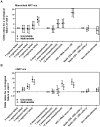Impact of previous virological treatment failures and adherence on the outcome of antiretroviral therapy in 2007
- PMID: 20011544
- PMCID: PMC2789943
- DOI: 10.1371/journal.pone.0008275
Impact of previous virological treatment failures and adherence on the outcome of antiretroviral therapy in 2007
Abstract
Background: Combination antiretroviral treatment (cART) has been very successful, especially among selected patients in clinical trials. The aim of this study was to describe outcomes of cART on the population level in a large national cohort.
Methods: Characteristics of participants of the Swiss HIV Cohort Study on stable cART at two semiannual visits in 2007 were analyzed with respect to era of treatment initiation, number of previous virologically failed regimens and self reported adherence. Starting ART in the mono/dual era before HIV-1 RNA assays became available was counted as one failed regimen. Logistic regression was used to identify risk factors for virological failure between the two consecutive visits.
Results: Of 4541 patients 31.2% and 68.8% had initiated therapy in the mono/dual and cART era, respectively, and been on treatment for a median of 11.7 vs. 5.7 years. At visit 1 in 2007, the mean number of previous failed regimens was 3.2 vs. 0.5 and the viral load was undetectable (<50 copies/ml) in 84.6% vs. 89.1% of the participants, respectively. Adjusted odds ratios of a detectable viral load at visit 2 for participants from the mono/dual era with a history of 2 and 3, 4, >4 previous failures compared to 1 were 0.9 (95% CI 0.4-1.7), 0.8 (0.4-1.6), 1.6 (0.8-3.2), 3.3 (1.7-6.6) respectively, and 2.3 (1.1-4.8) for >2 missed cART doses during the last month, compared to perfect adherence. From the cART era, odds ratios with a history of 1, 2 and >2 previous failures compared to none were 1.8 (95% CI 1.3-2.5), 2.8 (1.7-4.5) and 7.8 (4.5-13.5), respectively, and 2.8 (1.6-4.8) for >2 missed cART doses during the last month, compared to perfect adherence.
Conclusions: A higher number of previous virologically failed regimens, and imperfect adherence to therapy were independent predictors of imminent virological failure.
Conflict of interest statement
Figures




Similar articles
-
Could caregiver reporting adherence help detect virological failure in Cameroonian early treated HIV-infected infants?BMC Pediatr. 2015 Sep 21;15:132. doi: 10.1186/s12887-015-0451-3. BMC Pediatr. 2015. PMID: 26391474 Free PMC article.
-
Effectiveness of antiretroviral regimens containing abacavir with tenofovir in treatment-experienced patients: predictors of virological response and drug resistance evolution in a multi-cohort study.Infection. 2009 Oct;37(5):438-44. doi: 10.1007/s15010-009-8237-x. Epub 2009 Aug 7. Infection. 2009. PMID: 19669091
-
Association between prescription cost sharing and adherence to initial combination antiretroviral therapy in commercially insured antiretroviral-naïve patients with HIV.J Manag Care Pharm. 2012 Mar;18(2):129-45. doi: 10.18553/jmcp.2012.18.2.129. J Manag Care Pharm. 2012. PMID: 22380472 Free PMC article.
-
[National consensus document by GESIDA/National Aids Plan on antiretroviral treatment in adults infected by the human immunodeficiency virus (January 2011 update)].Enferm Infecc Microbiol Clin. 2011 Mar;29(3):209.e1-103. doi: 10.1016/j.eimc.2010.12.004. Enferm Infecc Microbiol Clin. 2011. PMID: 21388714 Spanish.
-
Short Cycle, Intermittent Therapy: A Valuable Option in Selected, Virologically Suppressed People Living with HIV.AIDS Res Hum Retroviruses. 2024 Feb;40(2):69-72. doi: 10.1089/AID.2022.0168. Epub 2023 Aug 31. AIDS Res Hum Retroviruses. 2024. PMID: 37551977 Review.
Cited by
-
'What does that mean?': a qualitative exploration of the primary and secondary clinical care experiences of young people with continence problems in the UK.BMJ Open. 2017 Oct 16;7(10):e015544. doi: 10.1136/bmjopen-2016-015544. BMJ Open. 2017. PMID: 29042374 Free PMC article.
-
Getting less of what you want: reductions in statistical power and increased bias when categorizing medication adherence data.J Behav Med. 2016 Dec;39(6):969-980. doi: 10.1007/s10865-016-9727-9. Epub 2016 Feb 27. J Behav Med. 2016. PMID: 26921166 Free PMC article.
-
Living situation affects adherence to combination antiretroviral therapy in HIV-infected adolescents in Rwanda: a qualitative study.PLoS One. 2013;8(4):e60073. doi: 10.1371/journal.pone.0060073. Epub 2013 Apr 3. PLoS One. 2013. PMID: 23573232 Free PMC article.
-
Factors affecting adherence to treatment in children living with HIV.Indian J Sex Transm Dis AIDS. 2020 Jul-Dec;41(2):181-187. doi: 10.4103/ijstd.IJSTD_43_18. Epub 2020 Jul 31. Indian J Sex Transm Dis AIDS. 2020. PMID: 33817591 Free PMC article.
-
The treatment of patients with HIV.Dtsch Arztebl Int. 2010 Jul;107(28-29):507-15; quiz 516. doi: 10.3238/arztebl.2010.0507. Epub 2010 Jul 12. Dtsch Arztebl Int. 2010. PMID: 20703338 Free PMC article. Review.
References
-
- The Collaboration of Observational HIV Epidemiological Research Europe (COHERE) study group. Response to combination antiretroviral therapy: variation by age. AIDS. 2008;22:1463–1473. - PubMed
-
- Bartlett JA, Chen SS, Quinn JB. Comparative efficacy of nucleoside/nucleotide reverse transcriptase inhibitors in combination with efavirenz: results of a systematic overview. HIV Clin Trials. 2007;8:221–226. - PubMed
-
- Eron J,, Jr., Yeni P, Gathe J,, Jr., Estrada V, DeJesus E, et al. The KLEAN study of fosamprenavir-ritonavir versus lopinavir-ritonavir, each in combination with abacavir-lamivudine, for initial treatment of HIV infection over 48 weeks: a randomised non-inferiority trial. Lancet. 2006;368:476–482. - PubMed
-
- Cooper D, Gatell J, Rockstroh J, Katlama C, Yeni P, et al. 48-week results from BENCHMRK-1, a phase III study of raltegravir in patients failing ART with triple-class resistant HIV-1. 15th Conference on Retroviruses and Opportunistic Infections, February 3–6, Boston Ma, Abstract #. 2008;788

